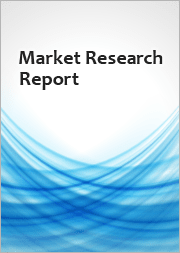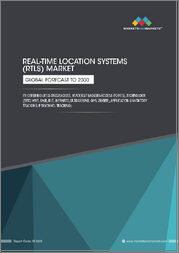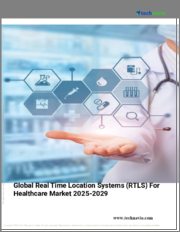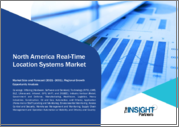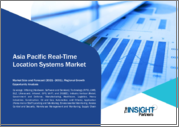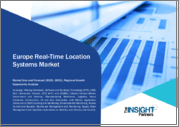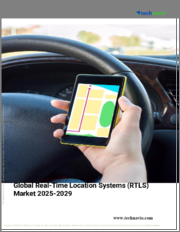
|
시장보고서
상품코드
1660661
실시간 위치추적 시스템 시장 보고서 : 구성 요소, 기술, 용도, 업계별, 지역별(2025-2033년)Real Time Location System Market Report by Component, Technology (RFID, Wi-Fi, UWB, BLE, Infrared, Ultrasound, GPS, and Others), Application, Vertical, and Region 2025-2033 |
||||||
세계의 실시간 위치추적 시스템 시장 규모는 2024년 92억 달러에 달했습니다. 향후 IMARC Group은 시장이 2033년까지 683억 달러에 이르며 2025년부터 2033년까지 23.64%의 성장률(CAGR)을 나타낼 것으로 예측했습니다. 이 시장은 다양한 산업에서 업무 효율화의 요구가 높아지고 있는 것, 생산 공정 전체를 통해 자산, 재료, 제품을 추적하는 요구가 높아지고 있는 것, 도난 방지를 위해 차량, 화물, 드라이버의 실시간 추적에 주목이 모여 있는 것 등이 배경에 있어 꾸준한 성장을 이루고 있습니다.
실시간 위치추적 시스템 시장 동향 :
업무 효율화 요구
다양한 산업에서 업무 효율화의 요구가 높아지고 있으며 시장 전망은 양호합니다. 공정 합리화, 비용 절감, 생산성 향상을 위해 RTLS를 채용하는 기업이 늘고 있습니다. 의료 분야에서 RTLS는 병원 내의 의료기기, 환자 및 직원의 위치를 실시간으로 추적하는 데 사용되며 신속한 대응과 효율적인 자원 할당을 실현합니다. 물류 및 공급망 기업도 RTLS를 이용하여 물품의 이동을 모니터링함으로써 경로 최적화, 운송 시간 단축, 재고 손실 최소화를 실현하고 있습니다. 제조시설에서는 재료와 자산의 움직임을 추적함으로써 RTLS의 혜택을 누리며 생산 공정의 개선과 다운타임의 단축으로 이어집니다.
안전과 보안에 대한 우려
안전과 보안에 대한 우려는 자산, 인력 및 귀중한 자원을 보호하기 위해 RTLS를 도입하도록 각 업계에 촉구합니다. 또한 유아 유괴와 치매 환자의 도망과 같은 사고를 예방하고 건강 관리 시설의 전반적인 보안을 강화하는 데 도움이 됩니다. 또한 산업 환경, 특히 화학 공장 및 건설 현장과 같은 위험한 환경에서 RTLS는 작업자 및 장비를 추적할 수 있습니다. 이를 통해 긴급 상황이나 사고 시 실시간으로 정보를 제공하고 작업자의 안전을 보장할 수 있습니다. 운송 분야에서 RTLS는 승객과 물품의 안전 확보에 중요한 역할을 합니다. 차량, 화물 및 운전자를 실시간으로 추적할 수 있으므로 도난을 방지하고 사고와 지연에 신속하게 대응할 수 있습니다.
사물 인터넷(IoT) 통합 및 인더스트리 4.0
RTLS와 사물인터넷(IoT)의 통합은 Industry 4.0 도입 증가와 함께 시장 성장을 가속하고 있습니다. 산업의 디지털화가 진행되고 있는 가운데, RTLS는 실시간 데이터 교환과 자동화를 가능하게 하는 매우 중요한 역할을 담당하고 있습니다.
제조업에서 RTLS는 Industry 4.0 이니셔티브의 핵심입니다. RTLS는 생산 공정 전반에 걸쳐 자산, 재료 및 제품 추적을 가능하게 하고, 예지 보전을 실현하고, 다운타임을 줄이고, 품질 관리를 보장합니다. 공급망과 물류 업무를 통해 제품의 움직임을 엔드 투 엔드로 시각화함으로써 IoT 통합 RTLS의 이점을 누릴 수 있습니다. 이는 재고 관리 최적화, 지연 감소, 수요 예측 개선으로 이어집니다.
진화하는 건강 관리의 필요
헬스케어 분야의 요구의 진화가 시장의 성장을 강화하고 있습니다. 건강 관리 시설은 더 나은 환자 관리를 제공하고 업무를 최적화하기 위해 노력하고 있기 때문에 RTLS 솔루션은 필수적입니다. 헬스케어에서는 환자의 안전과 케어의 질이 가장 중요합니다. 이러한 솔루션은 병원 내 환자, 직원 및 의료기기의 실시간 추적을 가능하게 합니다. 환자가 적시에 치료를 받을 수 있도록 하고 오류의 위험을 최소화하고 전반적인 환자 만족도를 향상시킵니다. 의료기관은 주입 펌프, 제세동기, 인공호흡기 등 귀중한 의료기기를 추적하는 자산 관리에도 RTLS를 사용합니다.
목차
제1장 서문
제2장 조사 범위와 조사 방법
- 조사의 목적
- 이해관계자
- 데이터 소스
- 1차 정보
- 2차 정보
- 시장 추정
- 상향식 접근
- 하향식 접근
- 조사 방법
제3장 주요 요약
제4장 소개
- 개요
- 주요 업계 동향
제5장 세계의 실시간 위치추적 시스템 시장
- 시장 개요
- 시장 실적
- COVID-19의 영향
- 시장 예측
제6장 시장 분석 : 구성 요소별
- 하드웨어
- 시장 동향
- 시장 예측
- 소프트웨어
- 시장 동향
- 시장 예측
- 서비스
- 시장 동향
- 시장 예측
제7장 시장 분석 : 기술별
- RFID
- 시장 동향
- 시장 예측
- Wi-Fi
- 시장 동향
- 시장 예측
- 초광대역
- 시장 동향
- 시장 예측
- BLE
- 시장 동향
- 시장 예측
- 적외선(IR)
- 시장 동향
- 시장 예측
- 초음파
- 시장 동향
- 시장 예측
- GPS
- 시장 동향
- 시장 예측
- 기타
- 시장 동향
- 시장 예측
제8장 시장 분석 : 용도별
- 재고/자산 추적 및 관리
- 시장 동향
- 시장 예측
- 개인/직원 위치 찾기와 모니터링
- 시장 동향
- 시장 예측
- 액세스 제어/보안
- 시장 동향
- 시장 예측
- 환경 모니터링
- 시장 동향
- 시장 예측
- 야드, 도크, 차량 창고 관리 및 모니터링
- 시장 동향
- 시장 예측
- 공급망 관리 및 운영 자동화/가시성
- 시장 동향
- 시장 예측
- 기타
- 시장 동향
- 시장 예측
제9장 시장 분석 : 업계별
- 헬스케어
- 시장 동향
- 시장 예측
- 제조업과 자동차
- 시장 동향
- 시장 예측
- 소매
- 시장 동향
- 시장 예측
- 운송 및 물류
- 시장 동향
- 시장 예측
- 정부 및 방위
- 시장 동향
- 시장 예측
- 교육
- 시장 동향
- 시장 예측
- 석유 및 가스, 광업
- 시장 동향
- 시장 예측
- 스포츠 및 엔터테인먼트
- 시장 동향
- 시장 예측
- 기타
- 시장 동향
- 시장 예측
제10장 시장 분석 : 지역별
- 북미
- 미국
- 캐나다
- 유럽
- 독일
- 프랑스
- 영국
- 이탈리아
- 스페인
- 러시아
- 기타
- 아시아태평양
- 중국
- 일본
- 인도
- 한국
- 호주
- 인도네시아
- 기타
- 라틴아메리카
- 브라질
- 멕시코
- 아르헨티나
- 콜롬비아
- 칠레
- 페루
- 기타
- 중동 및 아프리카
- 터키
- 사우디아라비아
- 이란
- 아랍에미리트(UAE)
- 기타
제11장 SWOT 분석
- 개요
- 강점
- 약점
- 기회
- 위협
제12장 밸류체인 분석
제13장 Porter's Five Forces 분석
- 개요
- 구매자의 협상력
- 공급기업의 협상력
- 경쟁도
- 신규 참가업체의 위협
- 대체품의 위협
제14장 경쟁 구도
- 시장 구조
- 주요 기업
- 주요 기업 프로파일
- AeroScout Inc.
- AiRISTA
- Alien Technology
- Axcess International Inc.
- CenTrak Healthcare Company
- DecaWave Limited
- Ekahau Inc.
- Identech Group AG
- Impinj
- Savi Technology
- Sonitor Technologies
- Stanley Healthcare
- TeleTracking Technologies
- Ubisense Group
- Zebra Technologies
The global real time location system market size reached USD 9.2 Billion in 2024. Looking forward, IMARC Group expects the market to reach USD 68.3 Billion by 2033, exhibiting a growth rate (CAGR) of 23.64% during 2025-2033. The market is experiencing steady growth driven by a considerable need for enhanced operational efficiency across various industries, rising need to track assets, materials, and products throughout the production process, and increasing focus on real-time tracking of vehicles, cargo, and drivers to prevent theft.
Real Time Location System Market Trends:
Operational efficiency demands
The growing need for enhanced operational efficiency across various industries is offering a favorable market outlook. Businesses are increasingly adopting RTLS to streamline their processes, reduce costs, and improve productivity. In the healthcare sector, RTLS is used to track the real-time location of medical equipment, patients, and staff within hospitals, resulting in quicker response times and efficient resource allocation. Logistics and supply chain companies also utilize RTLS to monitor the movement of goods, thereby optimizing routes, reducing transit times, and minimizing inventory losses. Manufacturing facilities benefit from RTLS by tracking the movement of materials and assets, leading to improved production processes and reduced downtime.
Safety and security concerns
Safety and security concerns are compelling industries to adopt RTLS for protecting assets, personnel, and valuable resources. It also helps in preventing incidents, such as infant abduction and elopement of dementia patients, enhancing overall security in healthcare premises. Moreover, within industrial settings, especially in hazardous environments like chemical plants or construction sites, RTLS can track workers and equipment. This ensures their safety by providing real-time information in case of emergencies or accidents. In the transportation sector, RTLS plays a crucial role in ensuring the safety of passengers and goods. It allows real-time tracking of vehicles, cargo, and drivers, helping prevent theft and respond swiftly to accidents or delays.
Internet of Things (IoT) integration and Industry 4.0
The integration of RTLS with the Internet of Things (IoT), along with the rising adoption of Industry 4.0, is propelling the growth of the market. As industries are increasingly digitizing their operations, RTLS plays a pivotal role in enabling real-time data exchange and automation.
In manufacturing, RTLS is a cornerstone of Industry 4.0 initiatives. It allows for the tracking of assets, materials, and products throughout the production process, enabling predictive maintenance, reducing downtime, and ensuring quality control. Supply chain and logistics operations benefit from IoT-integrated RTLS by providing end-to-end visibility into the movement of goods. This leads to optimized inventory management, reduced delays, and improved demand forecasting.
Evolving healthcare needs
The evolving needs of the healthcare sector are strengthening the growth of the market. As healthcare facilities are striving to provide better patient care and optimize their operations, RTLS solutions are becoming indispensable. Patient safety and care quality are paramount in healthcare. These solutions enable real-time tracking of patients, staff, and medical equipment within hospitals. They ensure that patients receive timely care, minimize the risk of errors, and enhance overall patient satisfaction. Healthcare institutions also use RTLS for asset management, tracking valuable medical equipment, such as infusion pumps, defibrillators, and ventilators.
Real Time Location System Industry Segmentation:
Breakup by Component:
- Hardware
- Software
- Services
Hardware accounts for the majority of the market share
Breakup by Technology:
- RFID
- Wi-Fi
- UWB
- BLE
- Infrared (IR)
- Ultrasound
- GPS
- Others
RFID holds the largest share in the industry
Breakup by Application:
- Inventory/Asset-Tracking & Management
- Personnel/Staff-Locating & Monitoring
- Access Control/Security
- Environmental Monitoring
- Yard, Dock, Fleet Warehouse-Management & Monitoring
- Supply Chain Management & Operational Automation/Visibility
- Others
Inventory or asset-tracking and management represents the leading market segment
Breakup by Vertical:
- Healthcare
- Manufacturing & Automotive
- Retail
- Transportation & Logistics
- Government & Defense
- Education
- Oil & Gas, Mining
- Sports & Entertainment
- Others
Healthcare exhibits a clear dominance in the market
Breakup by Region
- North America
- United States
- Canada
- Europe
- Germany
- France
- United Kingdom
- Italy
- Spain
- Russia
- Others
- Asia Pacific
- China
- Japan
- India
- South Korea
- Australia
- Indonesia
- Others
- Latin America
- Brazil
- Mexico
- Argentina
- Colombia
- Chile
- Peru
- Others
- Middle East and Africa
- Turkey
- Saudi Arabia
- Iran
- United Arab Emirates
- Others
North America leads the market, accounting for the largest real time location system market share
The market research report has also provided a comprehensive analysis of all the major regional markets, which include North America (the United States and Canada); Europe (Germany, France, the United Kingdom, Italy, Spain, Russia, and others); Asia Pacific (China, Japan, India, South Korea, Australia, Indonesia, and others); Latin America (Brazil, Mexico, Argentina, Colombia, Chile, Peru, and others); and the Middle East and Africa (Turkey, Saudi Arabia, Iran, United Arab Emirates, and others). According to the report, North America accounted for the largest market share due to the extensive implementation of RTLS solutions across various industries, including healthcare, manufacturing, logistics, and retail. The United States is a major contributor to the growth of the RTLS market, with its healthcare sector showing strong demand for patient tracking and asset management solutions. Additionally, technological advancements and early adoption of IoT and Industry 4.0 are impelling the market growth in the region.
The market research report has provided a comprehensive analysis of the competitive landscape. Detailed profiles of all major companies have also been provided. Some of the key players in the market include:
- AeroScout Inc.
- AiRISTA
- Alien Technology
- Axcess International Inc.
- CenTrak Healthcare Company
- DecaWave Limited
- Ekahau Inc.
- Identech Group AG
- Impinj
- Savi Technology
- Sonitor Technologies
- Stanley Healthcare
- TeleTracking Technologies
- Ubisense Group
- Zebra Technologies
Key Questions Answered in This Report
- 1.What was the size of the global real time location system market in 2024?
- 2.What is the expected growth rate of the global real time location system market during 2025-2033?
- 3.What are the key factors driving the global real time location system market?
- 4.What has been the impact of COVID-19 on the global real time location system market?
- 5.What is the breakup of the global real time location system market based on the component?
- 6.What is the breakup of the global real time location system market based on the technology?
- 7.What is the breakup of the global real time location system market based on application?
- 8.What is the breakup of the global real time location system market based on the vertical?
- 9.What are the key regions in the global real time location system market?
- 10.Who are the key players/companies in the global real time location system market?
Table of Contents
1 Preface
2 Scope and Methodology
- 2.1 Objectives of the Study
- 2.2 Stakeholders
- 2.3 Data Sources
- 2.3.1 Primary Sources
- 2.3.2 Secondary Sources
- 2.4 Market Estimation
- 2.4.1 Bottom-Up Approach
- 2.4.2 Top-Down Approach
- 2.5 Forecasting Methodology
3 Executive Summary
4 Introduction
- 4.1 Overview
- 4.2 Key Industry Trends
5 Global Real Time Location System Market
- 5.1 Market Overview
- 5.2 Market Performance
- 5.3 Impact of COVID-19
- 5.4 Market Forecast
6 Market Breakup by Component
- 6.1 Hardware
- 6.1.1 Market Trends
- 6.1.2 Market Forecast
- 6.2 Software
- 6.2.1 Market Trends
- 6.2.2 Market Forecast
- 6.3 Services
- 6.3.1 Market Trends
- 6.3.2 Market Forecast
7 Market Breakup by Technology
- 7.1 RFID
- 7.1.1 Market Trends
- 7.1.2 Market Forecast
- 7.2 Wi-Fi
- 7.2.1 Market Trends
- 7.2.2 Market Forecast
- 7.3 UWB
- 7.3.1 Market Trends
- 7.3.2 Market Forecast
- 7.4 BLE
- 7.4.1 Market Trends
- 7.4.2 Market Forecast
- 7.5 Infrared (IR)
- 7.5.1 Market Trends
- 7.5.2 Market Forecast
- 7.6 Ultrasound
- 7.6.1 Market Trends
- 7.6.2 Market Forecast
- 7.7 GPS
- 7.7.1 Market Trends
- 7.7.2 Market Forecast
- 7.8 Others
- 7.8.1 Market Trends
- 7.8.2 Market Forecast
8 Market Breakup by Application
- 8.1 Inventory/Asset-Tracking & Management
- 8.1.1 Market Trends
- 8.1.2 Market Forecast
- 8.2 Personnel/Staff-Locating & Monitoring
- 8.2.1 Market Trends
- 8.2.2 Market Forecast
- 8.3 Access Control/Security
- 8.3.1 Market Trends
- 8.3.2 Market Forecast
- 8.4 Environmental Monitoring
- 8.4.1 Market Trends
- 8.4.2 Market Forecast
- 8.5 Yard, Dock, Fleet Warehouse-Management & Monitoring
- 8.5.1 Market Trends
- 8.5.2 Market Forecast
- 8.6 Supply Chain Management & Operational Automation/Visibility
- 8.6.1 Market Trends
- 8.6.2 Market Forecast
- 8.7 Others
- 8.7.1 Market Trends
- 8.7.2 Market Forecast
9 Market Breakup by Vertical
- 9.1 Healthcare
- 9.1.1 Market Trends
- 9.1.2 Market Forecast
- 9.2 Manufacturing & Automotive
- 9.2.1 Market Trends
- 9.2.2 Market Forecast
- 9.3 Retail
- 9.3.1 Market Trends
- 9.3.2 Market Forecast
- 9.4 Transportation & Logistics
- 9.4.1 Market Trends
- 9.4.2 Market Forecast
- 9.5 Government & Defense
- 9.5.1 Market Trends
- 9.5.2 Market Forecast
- 9.6 Education
- 9.6.1 Market Trends
- 9.6.2 Market Forecast
- 9.7 Oil & Gas, Mining
- 9.7.1 Market Trends
- 9.7.2 Market Forecast
- 9.8 Sports & Entertainment
- 9.8.1 Market Trends
- 9.8.2 Market Forecast
- 9.9 Others
- 9.9.1 Market Trends
- 9.9.2 Market Forecast
10 Market Breakup by Region
- 10.1 North America
- 10.1.1 United States
- 10.1.1.1 Market Trends
- 10.1.1.2 Market Forecast
- 10.1.2 Canada
- 10.1.2.1 Market Trends
- 10.1.2.2 Market Forecast
- 10.1.1 United States
- 10.2 Europe
- 10.2.1 Germany
- 10.2.1.1 Market Trends
- 10.2.1.2 Market Forecast
- 10.2.2 France
- 10.2.2.1 Market Trends
- 10.2.2.2 Market Forecast
- 10.2.3 United Kingdom
- 10.2.3.1 Market Trends
- 10.2.3.2 Market Forecast
- 10.2.4 Italy
- 10.2.4.1 Market Trends
- 10.2.4.2 Market Forecast
- 10.2.5 Spain
- 10.2.5.1 Market Trends
- 10.2.5.2 Market Forecast
- 10.2.6 Russia
- 10.2.6.1 Market Trends
- 10.2.6.2 Market Forecast
- 10.2.7 Others
- 10.2.7.1 Market Trends
- 10.2.7.2 Market Forecast
- 10.2.1 Germany
- 10.3 Asia Pacific
- 10.3.1 China
- 10.3.1.1 Market Trends
- 10.3.1.2 Market Forecast
- 10.3.2 Japan
- 10.3.2.1 Market Trends
- 10.3.2.2 Market Forecast
- 10.3.3 India
- 10.3.3.1 Market Trends
- 10.3.3.2 Market Forecast
- 10.3.4 South Korea
- 10.3.4.1 Market Trends
- 10.3.4.2 Market Forecast
- 10.3.5 Australia
- 10.3.5.1 Market Trends
- 10.3.5.2 Market Forecast
- 10.3.6 Indonesia
- 10.3.6.1 Market Trends
- 10.3.6.2 Market Forecast
- 10.3.7 Others
- 10.3.7.1 Market Trends
- 10.3.7.2 Market Forecast
- 10.3.1 China
- 10.4 Latin America
- 10.4.1 Brazil
- 10.4.1.1 Market Trends
- 10.4.1.2 Market Forecast
- 10.4.2 Mexico
- 10.4.2.1 Market Trends
- 10.4.2.2 Market Forecast
- 10.4.3 Argentina
- 10.4.3.1 Market Trends
- 10.4.3.2 Market Forecast
- 10.4.4 Colombia
- 10.4.4.1 Market Trends
- 10.4.4.2 Market Forecast
- 10.4.5 Chile
- 10.4.5.1 Market Trends
- 10.4.5.2 Market Forecast
- 10.4.6 Peru
- 10.4.6.1 Market Trends
- 10.4.6.2 Market Forecast
- 10.4.7 Others
- 10.4.7.1 Market Trends
- 10.4.7.2 Market Forecast
- 10.4.1 Brazil
- 10.5 Middle East and Africa
- 10.5.1 Turkey
- 10.5.1.1 Market Trends
- 10.5.1.2 Market Forecast
- 10.5.2 Saudi Arabia
- 10.5.2.1 Market Trends
- 10.5.2.2 Market Forecast
- 10.5.3 Iran
- 10.5.3.1 Market Trends
- 10.5.3.2 Market Forecast
- 10.5.4 United Arab Emirates
- 10.5.4.1 Market Trends
- 10.5.4.2 Market Forecast
- 10.5.5 Others
- 10.5.5.1 Market Trends
- 10.5.5.2 Market Forecast
- 10.5.1 Turkey
11 SWOT Analysis
- 11.1 Overview
- 11.2 Strengths
- 11.3 Weaknesses
- 11.4 Opportunities
- 11.5 Threats
12 Value Chain Analysis
13 Porters Five Forces Analysis
- 13.1 Overview
- 13.2 Bargaining Power of Buyers
- 13.3 Bargaining Power of Suppliers
- 13.4 Degree of Competition
- 13.5 Threat of New Entrants
- 13.6 Threat of Substitutes
14 Competitive Landscape
- 14.1 Market Structure
- 14.2 Key Players
- 14.3 Profiles of Key Players
- 14.3.1 AeroScout Inc.
- 14.3.1.1 Company Overview
- 14.3.1.2 Product Portfolio
- 14.3.2 AiRISTA
- 14.3.2.1 Company Overview
- 14.3.2.2 Product Portfolio
- 14.3.2.3 Financials
- 14.3.2.4 SWOT Analysis
- 14.3.3 Alien Technology
- 14.3.3.1 Company Overview
- 14.3.3.2 Product Portfolio
- 14.3.4 Axcess International Inc.
- 14.3.4.1 Company Overview
- 14.3.4.2 Product Portfolio
- 14.3.5 CenTrak Healthcare Company
- 14.3.5.1 Company Overview
- 14.3.5.2 Product Portfolio
- 14.3.6 DecaWave Limited
- 14.3.6.1 Company Overview
- 14.3.6.2 Product Portfolio
- 14.3.7 Ekahau Inc.
- 14.3.7.1 Company Overview
- 14.3.7.2 Product Portfolio
- 14.3.8 Identech Group AG
- 14.3.8.1 Company Overview
- 14.3.8.2 Product Portfolio
- 14.3.9 Impinj
- 14.3.9.1 Company Overview
- 14.3.9.2 Product Portfolio
- 14.3.9.3 Financials
- 14.3.10 Savi Technology
- 14.3.10.1 Company Overview
- 14.3.10.2 Product Portfolio
- 14.3.11 Sonitor Technologies
- 14.3.11.1 Company Overview
- 14.3.11.2 Product Portfolio
- 14.3.12 Stanley Healthcare
- 14.3.12.1 Company Overview
- 14.3.12.2 Product Portfolio
- 14.3.13 TeleTracking Technologies
- 14.3.13.1 Company Overview
- 14.3.13.2 Product Portfolio
- 14.3.14 Ubisense Group
- 14.3.14.1 Company Overview
- 14.3.14.2 Product Portfolio
- 14.3.15 Zebra Technologies
- 14.3.15.1 Company Overview
- 14.3.15.2 Product Portfolio
- 14.3.15.3 Financials
- 14.3.15.4 SWOT Analysis
- 14.3.1 AeroScout Inc.






